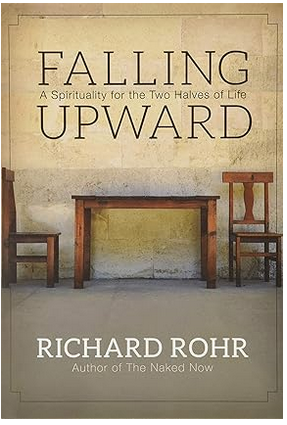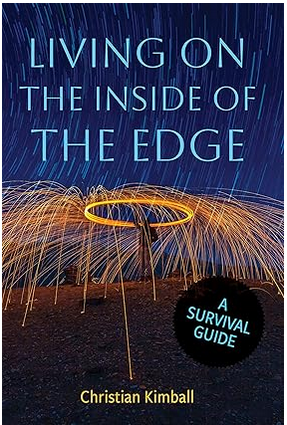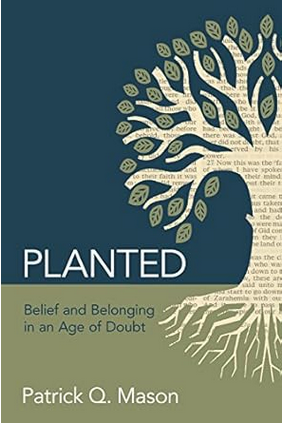Marvel not that I said unto thee, Ye must be born again.
John 3:7
We’ve found that practicing religion is a journey with various twists and turns. The faith that once sustained someone and provided meaning and purpose in one phase of life can fail to do so in another phase of life. Like manna that spoils and must be gathered anew, faith requires re-framing, remodeling, and repair. This is more than merely doubling down on how you already approach faith. Like Richard Rohr states,
…authentic God experience always “burns” you, yet does not destroy you (Exodus 3:2-3), just as the burning bush did to Moses. But most of us are not prepared for such burning, nor even told to expect it… It consoles our True Self only after it has devastated our false self. We must begin to be honest about this instead of dishing out fast-food religion.
Richard Rohr, Falling Upward
Because this “burning” and “rebirth” are, by their nature, unpredictable in how they will manifest in and disrupt your own life these resources can’t provide ready-made formulas or rules to follow. But the following resources either describe this process and/or are from authors who have expressed going through this phenomenon.

Falling Upward by Richard Rohr
Richard Rohr is a Franciscan priest who has written extensively on spirituality, alternative orthodoxy, with a focus on orthopraxy. In this book he lays out two halves of life (as a model). The first half is about experiencing God from the outside via rules, tradition, identity, authority figures, and conforming to what is given. The second half is about experiencing God from the inside via intuition, longing, agency, and self-determination.
The difficult part, as he puts it is:
Early stage religion is largely preparing you for the immense gift of this burning, this inner experience of God, as though creating a proper stable into which the Christ can be born. Unfortunately, most people get so preoccupied with their stable, and whether their stable is better than your stable, or whether their stable is the [“only True and Living, authorized”], “apostolic” stable, that they never get to the birth of God in the soul.
(brackets added to tweak wording for Latter-day Saint audience)
In the book, he walks through stages and pivot points as someone goes through this journey offering guidance through the process.
Letters to a Young Mormon by Adam Miller
Much like his other books, Adam Miller re-frames familiar topics in a way the reveals their enduring power. He goes through several high-level topics: agency, work, sin, faith, scripture, prayer, history, science, hunger, sex, temples, and eternal life and weaves a bluntly honest, but soaringly hopeful picture of these things in a format and language accessible to youth. But don’t let the title limit the audience. His questions, framings, honest observations, and faith can be a balm of healing to the hearts and minds of adults and youth alike. The book reads as someone in that second half of life (as Rohr puts it) reaching out to someone in the first half of life, describing the journey they took through that transformation.
Simply Jesus by N. T. Wright
In “Simply Jesus”, NT Wright expertly immerses the reader into the time of Jesus to create the setting and framework necessary to understand Jesus the way his first disciples understood him and, more importantly, to get at understanding how Jesus understood his own work and mission. Much of the book is spent painting this historical canvas which constantly must be cleared of our modern way of thinking.
The book does a good job showing how Jesus resists the boxes we tend to try to place him in (the boxes given us in that first half of life) and challenges the reader to think more robustly about the mission and meaning of Jesus’ teachings and the work of building the kingdom of heaven.
I sometimes describe this book as being able to do for Latter-day Saint understanding of Jesus what CS Lewis’ “Mere Christianity” did for many Latter-day Saint’s understanding of Christianity.
The Bible Tells Me So by Peter Enns
Peter Enns creates a strong case for changing the paradigm with which we read the Bible. His book ‘The Bible Tells Me So’ is written in a colloquial voice (which can feel a bit informal for the topic) but which works because his points are well researched and he is able to reach a wider audience.
The main point he makes is that we need to step away from trying to fit the Bible’s various authors into one harmonious, historical, rule book (which is what is given to us commonly in the first half of life) and embrace the fact that there are a variety of sometimes contradicting and non-historical voices. As we embrace that we can come to realize God is letting mankind tell their own, messy story of how they understand and struggle to know God. This makes us better able to read the Bible on its own terms and see how our struggles in faith are welcome as we strive to trust God and tell our own story.
Grace Is Not God’s Backup Plan by Adam Miller
In “grace is Not God’s Backup Plan”, Adam Miller does a strenuous, modern translation (or remix) of the book of Romans. His translation is ecumenical, broadly accessible, and does a great job capturing the essence of Paul which, in some Bible translations, can be hard to parse. From a Latter-Day Saint perspective, I sometimes describe this book as doing for our understanding of grace today what Steven Robinson’s “Believing Christ” did for it in its day. Adam Miller echoes Paul’s teaching that grace is fundamental and presupposed by God and it is our sin that is a rejection of this grace rather than grace being seen as a stop-gap measure minimally applied - a paradigm shift that can greatly help in moving from one stage of life to another.
Living on the Edge of Inside by Christian Kimball
Christian Kimball writes this book as a kind of “survival guide” for those who may feel like they don’t quite fit neatly into religious tradition. In the framing of first and second halves of life, this guide could be helpful for someone transitioning or well into second half of life who would like some tools to approach aspects of religion and church - in the Latter-day Saint tradition.
The author provides some helpful framing of this journey in terms of psychological differentiation. This process of re-approaching and re-negotiating one’s orthodoxy (beliefs) and orthopraxy (actions) in how they live their faith can be better navigated by thinking of it in terms of differentiation. This guide isn’t theoretical however, as Christian Kimball provides very practical, and specific approaches in engaging with various aspects of Latter-day Saint church and traditions. Some may or may not work for you, but the author can help you think through how to engage in ways that otherwise may not have been thought possible (and avoid all-or-nothing approaches).
Planted by Patrick Mason
Patrick Q. Mason provides several approaches to faith in the modern era from the perspective of how religion can do better or how it can leave people out. He writes about how religious adherents can feel “switched off” (dis-enthralled or distrusting of their religious tradition), or “squeezed out” (feeling marginalized or excluded from a religious tradition’s norms or expectations). While not written explicitly from a faith journey perspective, this book provides plenty of tools and framing that can help someone navigate through faith as it shifts and grows through life.
Podcasts / Videos
Beyond books, the following podcast episodes or video presentations are good introductions and discussions on this topic:




![Simply Jesus: A New Vision of Who He Was, What He Did, and Why He Matters by [Wright, N. T.]](https://images-na.ssl-images-amazon.com/images/I/41HA0WrZr5L.jpg)
![The Bible Tells Me So: Why Defending Scripture Has Made Us Unable to Read It by [Enns, Peter]](https://images-na.ssl-images-amazon.com/images/I/412YrGLaYlL.jpg)


